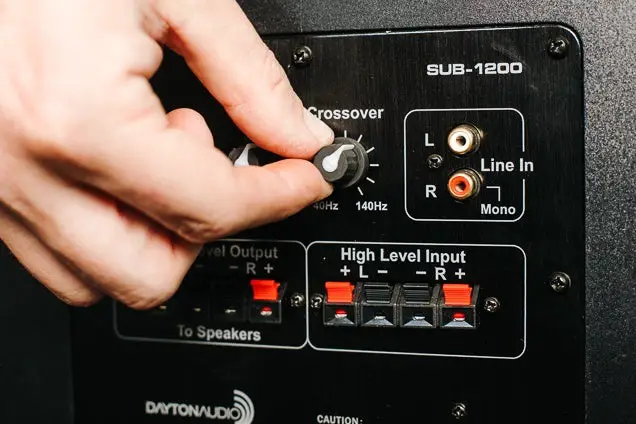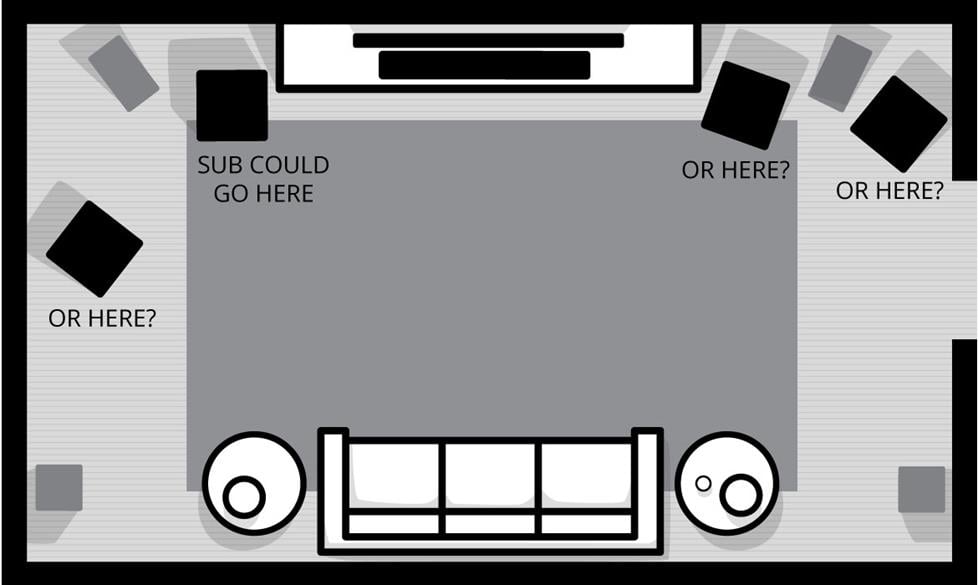Subwoofers play a crucial role in home theater setups. They improve the entire audio experience by reproducing low-frequency sounds. However, they do tend to produce muffled sounds from time to time, which is a very frustrating issue to deal with.
But why does the subwoofer sounds muffled?
Your subwoofer can start producing muffled sounds when the crossover settings are incorrect, the subwoofers have been overdriven, or when the equalization is improper. This problem may also be caused by a damaged speaker, a distorted amplifier, and limited frequency response. Poor placement and room acoustics can also cause these annoying issues and a couple of other factors.
Whether you’re a home theater enthusiast or a music lover, understanding how to improve subwoofer performance helps to enjoy immersive music. In this article, we’ll look at a few of the common reasons for muffled subwoofer sound and how to solve them.
Why Does Your Subwoofer Sounds Muffled?
When the subwoofer is unable to transmit low-frequency focused sound properly, it starts sounding muffled. The reason behind it could be a number of things. Here is a list of the possible reasons for muffled subwoofer sounds.
| Reasons | Solution |
| Incorrect Crossover Settings | Adjust crossover settings |
| Lack of Proper Equalization | Adjust the low-pass filter, phase, gain, and bass boost settings |
| Limited Frequency Response | Adjust Frequency Response |
| Overdriving | Adjust according to manual |
| Blocked Port | Clean the port |
| Damaged Speaker | Change the speaker |
| Distorted Amplifier | Check the manual and adjust, and replace the amplifier |
| Poor Placement & Room Acoustics | Relocate the amplifier |
To achieve the best sound quality, it’s crucial to check all of these settings and make the appropriate adjustments. Let’s dig deeper into these reasons and find a solution for them.
Reason 1: Incorrect Crossover Settings

For a subwoofer, 80Hz is the ideal crossover frequency. When this crossover frequency is set too high the subwoofer produces a muffled sound.
The audio frequencies are separated by the built-in crossover in the majority of subwoofers. After that, it is routed to the proper speakers. The crossover is typically located on the rear of the subwoofer or in its settings.
Your subwoofer manual will have specific instructions for checking the crossover settings. Access the crossover settings through that and see if it’s set at too high a frequency or not. Some subwoofers have built-in displays; you can look up the crossover frequency on that as well.
Solution:
Adjust the crossover frequency to a lower frequency, around 80 Hz. This will enable the subwoofer to play the lower frequencies. For detailed instructions, it is preferable to refer to the handbook or manufacturer’s website. Because different subwoofers have different features and settings.
Listen to the subwoofer after altering the crossover frequency to check if the audio has improved. You might need to tweak the crossover settings further if the subwoofer is still muffled.
Some subwoofers feature a phase setting. These phase settings can impact the subwoofer’s performance and cause it to seem muffled. Change to different phase settings to see which best suits your system.
Reasons 2: Lack of Proper Equalization
Without proper equalization the bass frequencies can be overly pronounced or too weak, resulting in a muffled sound.
The frequency response of the subwoofer can be measured with a sound meter. This will give you an overview of how the frequencies in the audio signal are harmonized. Additionally, it will show you whether the bass frequencies are too prominent or too soft.
You can also try a frequency analyzer to visualize the frequency response of the subwoofer. This helps in pointing out any sections where the frequency response is inadequate.
Solution:
Simply adjust the low-pass filter, phase, gain, and bass boost settings to enhance or cut the bass frequencies. Listen to the subwoofer after tweaking the equalization settings to determine if the sound has improved.
If the subwoofer still sounds muffled, you may need to make additional adjustments. Some subwoofers include built-in equalizers. Check to see if yours does and experiment with different built-in settings to find which one sounds the best.
Reason 3: Limited Frequency Response
Some subwoofers don’t accurately reproduce the lower frequencies because of limited frequency response. This usually happens when the home theater systems’ power outputs are not matched with one another. So, the sound is muffled as an outcome of this constraint.
Look at the subwoofer’s specifications in the manual or on the manufacturer’s website to find out the frequency response range. A sound meter can be used to determine the frequency response also.
The frequency analyzer may occasionally be used to visualize the subwoofer’s frequency response. This will help find the area where the frequency response is insufficient and help you make the necessary modifications.
Solution:
To solve this issue follow these steps one by one-
- Playing audio that includes different frequency ranges to see if the subwoofer can adequately reproduce all frequencies. Then play your normal bass-based audio to check if the subwoofer’s sound has improved. This approach is typically used to resolve minor concerns.
- If the problem appears to be serious, you need to adjust the frequency response of the subwoofer.
- You can adjust the EQ settings on the subwoofer or on the attached receiver/amplifier. Additionally, you can experiment with various subwoofer positioning options in the room.
Consider purchasing a subwoofer with a higher frequency response range if the subwoofer still sounds muffled.
Reason 4: Overdriving
Setting the volume too high may lead to overdriving the speaker which in turn causes sounds to be muffled. Overdriving is the practice of playing audio at a volume that exceeds the specified power handling capacity of the subwoofer.
The speaker of a subwoofer might suffer long-term damage as a result. It can even lead to the subwoofer bottoming out.
Additionally, a volume set too low won’t let the subwoofer adequately reproduce low-frequency sounds as well. As a result, the audio will be bound to get muffled.
Solution:
The best sound level for a subwoofer varies depending on the room size and location, as well as a personal choice. However, as a general rule, the subwoofer’s volume level should be balanced with the rest of the system’s speakers.
Set the subwoofer volume to a reasonable level, around 75-80 dB. Ensure that the subwoofer’s volume level is balanced with the system’s other speakers as well. Listen to a wide range of bass frequencies to see how the subwoofer sounds at various volume levels.
Decide on the volume that best suits your hearing preferences. But don’t pick too high as higher volume can result in distortion as well.
Reason 5: Blocked Port
The sound may be muffled if the subwoofer’s port is blocked and the subwoofer cannot pass the air properly. Inspect the subwoofer’s port or vent to see if any debris or dust buildup has clogged it.
Solution:
Use a soft brush or a vacuum to clean any dust or debris from the port. Change the placement of any furniture if it is too close to the subwoofer.
Check the subwoofer’s user manual for subwoofer placement and airflow suggestions. You can use compact cooling fans to keep minimum airflow.
Reason 5: Damaged Speaker
The subwoofer may sound muffled as a result of weak or distorted sound coming from a damaged speaker. Numerous factors, including overheating, might result in a malfunctioning speaker.
Overheating can harm the voice coil or magnet of the speaker, which can lead to distorted or unreliable sound. Long-term use at loud volume levels can harm the surround or diaphragm of the speaker. The speaker’s parts can deteriorate with time as well.
Look for any physical damage on the speaker, such as a hole or rip in the diaphragm, or disconnected wiring.
Solution:
In such scenarios, replacing the broken speaker is the best course of action. But sometimes, even minor changes like moving the speaker will be enough to stop the overheating. You should try to play at a moderate volume to avoid this issue in the future.
Reason 6: Distorted Amplifier
An amplifier is in charge of amplifying the audio signal and transmitting it to the subwoofer. It’s possible for the subwoofer to generate a faint or muffled sound if the amplifier itself is distorted.
Use a test signal and an oscilloscope or distortion analyzer to check whether your amplifier is distorted. Connect the test signal to the amplifier’s input, then use an oscilloscope or distortion analyzer to evaluate the output. Check for distortion by comparing the waveforms of the input and output.
Solution:
Each amplifier model comes with different sets of instructions. So check the subwoofer’s manual for tips on how to troubleshoot a distorted amplifier.
If the problem is still not resolved, it may be essential to buy a new amplifier. It might cost you some extra bucks now. But you can ensure that your other devices are not affected.
Reason 7: Poor Placement & Room Acoustics

The sound of the subwoofer can be impacted by the acoustics of the room. Hard surfaces like concrete or tile can cause sound to become muffled and echo. The sound may become boomy and muffled if the subwoofer is set up against a wall or in a corner.
Solution:
For best sound quality, make sure the subwoofer is positioned in a space that is open and free from walls and corners. Experiment with different subwoofer placements to discover the perfect fit. You can use carpet in the room to absorb sound and improve quality.
The Room EQ feature is another option. Based on the acoustics of the room, this feature modifies the subwoofer’s output.
It can be used to improve the sound of the subwoofer by accounting for any bass deficits caused by the size and layout of the space. But just a few subwoofer brands and newer versions come with this feature.
You can now identify the problem causing the subwoofer’s muffled sound. But how can you keep it in top condition and improve its sound?
5 Tips For Subwoofer To Sound Better
Whether you use a B & W or Klipsch subwoofer, maintaining your subwoofer on a regular basis can improve sound quality. Here are some subwoofer maintenance steps you may take:
- Regularly wipe off the subwoofer driver with a dry cloth to get rid of any dust or debris that may have gathered over time. While cleaning, look for cracks or holes in the subwoofer’s enclosure.
- Check that the subwoofer’s connections, audio, crossover, and power are secure and functional. At the same time, make sure the amplifier is receiving enough power.
- Keep an eye out for faults like distortion, bottoming out, and clipping, and fix them as soon as possible.
- Double-check the crossover and EQ settings. For the best possible audio quality, adjust the low-pass filter, bass boost, gain, and phase as necessary.
- Avoid using your home theater system for extended periods of time at high volume.
Frequently Asked Questions (FAQs):
What frequency response does a subwoofer need to perform at its best?
The upper range for the frequency response should be adjusted between 80 and 100 Hz for a subwoofer to perform at its best. The majority of songs, on the other hand, should sound nice in the lower range with a good response down about 35 Hz or so.
What sound does a broken Sub make?
A broken subwoofer makes distorted or muted sounds coming from it at all volume levels. The subwoofer should be unplugged and taken to a repair shop as soon as possible to see if anything can be done. But in the majority of cases, it’s advisable to purchase a new subwoofer.
Is it possible for dust to damage speakers?
Yes, it is possible for dust to damage your speaker. Excessive dust can wreak havoc on the wiring and speaker. The loudspeakers should be placed in a room that doesn’t collect a lot of dust. Additionally, you need to clean it from time to time with a dry cloth to prevent any dust from gathering on the whole system.
End Words
With that our discussion on the subwoofer sounds muffled comes to an end. The guidelines above should be enough to help you detect the underlying problem in your case. Go through them one by one to find the real culprit.
If you are not sure about fixing any one of the issues by yourself don’t hesitate to call for professional help.
Until next time!
Read also: Cinemark Vs AMC
